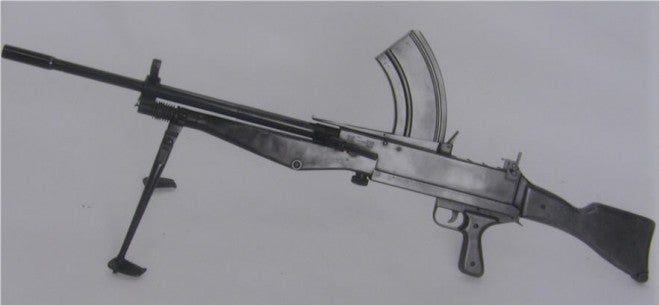One of the types of weapons that saw a lot of service in the period from 1918-1945 is the top-fed detachable magazine rifle-caliber light machine gun, or automatic rifle. Beginning with the Danish Madsen, reaching its height before and during World War II with platforms like the FM 24/29, ZB 26, and seeing continued service postwar (a notable example being the British L4, a legacy platform made from converted .303 caliber Bren guns, rechambered for 7.62×51 NATO and made compatible with standard issue rifle magazines, which saw service with its parent country into the 1990s), this type of weapon was a good compromise given the need for fully automatic firepower to augment the squad, while being lightweight and using the same ammunition supply as the rifleman. One such weapon that didn’t quite make it was the British Besal light machine gun, an article on which was recently posted to the Historical Firearms blog:
The Birmingham Small Arms company (BSA) were tasked with developing the design. BSA’s chief designer Henry Faulkner came up with a gun which became known as the Besal. The standards to which the Besal was to be produced were significantly lower than those of the standard Bren. It was believed that if the Besal was to be issued Britain would be engaged in a last ditch defence with German invasion either imminent or already underway.
Faulkner’s design was very much a simplified Bren gun, chambered in .303 feeding from standard Bren gun curved box magazines but using a basic trigger mechanism, simple pressed gas cylinder (positioned under the barrel like theBren) and body held together by pinning and spot welding. The weapon had a folding but non-adjustable bipod and a plain wooden butt stock. With the manufacture of barrels expected to be a bottleneck to the weapon’s production it was suggested that the spare barrel issued with each Bren gun be recalled for use in the new Besals. This shows just how desperate the situation was expected to be. The first prototype Besal was produced by BSA in 1941 and testing began in March 1942. The Besal proved to be reliable and effective during trials.
While last-ditch firearms of WWII are generally most closely associated with Germany and Japan, virtually all nations involved – including Britain – saw the need for expediently made firearms. The Besal certainly is a prime example of the desperation of the British in 1940, a situation which would thankfully prove fleeting as the Battle of Britain was won, and as the Americans joined the war late in ’41.
 Your Privacy Choices
Your Privacy Choices
